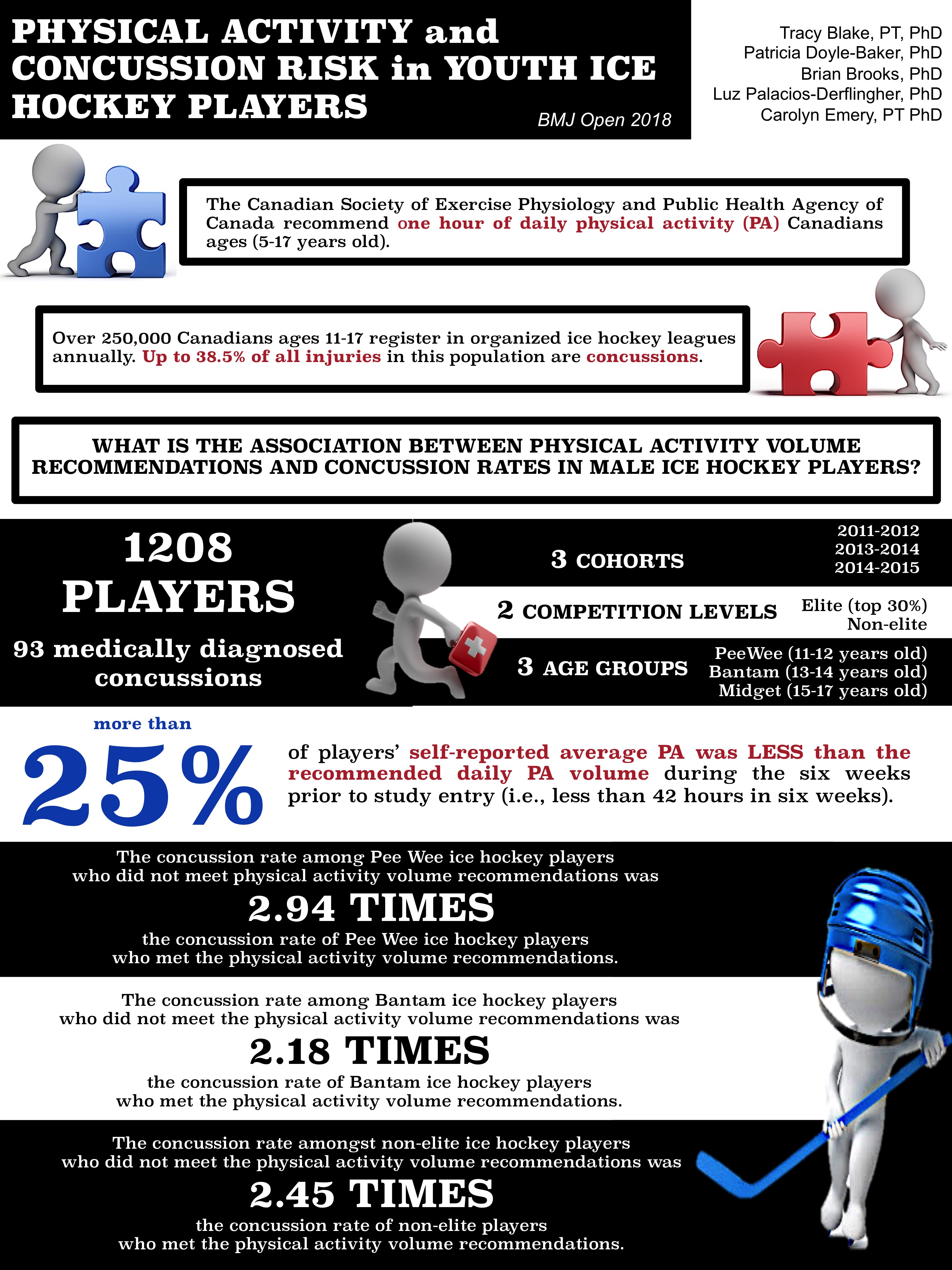
[Sheree Bekker] In this blog post, physiotherapist Tracy Blake, shares some key insights from both her injury prevention research and her experiences conducting research. In doing so, she shares some valuable considerations and implications.
Tracy Blake is a physiotherapist with over 12 years experience in the sport, orthopaedics, and acute inpatient settings, including working with athletes in over 20 sports at the local, national, and international level. She completed her PhD in Kinesiology (Sports Medicine) in 2016. In addition to her clinical practice, she is a freelance content developer, clinical assessor and research consultant, sport physiotherapy mentor, and co-lead of the Patient Voices initiative at the British Journal of Sports Medicine, which launches in Fall 2018.
[Tracy Blake] Research I conducted as part of my doctoral studies examining the association between physical activity (PA) volume recommendations and concussion risk in youth ice hockey players was recently published in BMJ Open. Seven years of living in, and with, this work has taught me a lot about perspective, context, and transparency in the research process. I thought I might share some examples with you.
The 2018 ParticipACTION report estimates that only 35% of Canadian children and youth are getting the recommended hour of moderate-vigorous of PA per day, despite approximately 77% of parents reporting their kids participation in organized sports. Our research shows that the popularity of ice hockey among Canadian children and youth does not make it immune to the physical inactivity pandemic. One in four study participants reported an average of less than one hour of daily PA in the six weeks leading up to entering the study. This finding illustrates the pervasiveness of physical inactivity, and the need for strategies targeting every demographic of our society to combat, including those with the means and the privilege of participating in organized sport.
We utilized a public health/health promotion approach, wherein the operationalization of PA metrics aligned with the recommendations of the Canadian Society of Exercise Physiology, and the Public Health Agency of Canada. The key finding is that the concussion rates among players who did not meet the PA volume recommendations were more than twice as high as the concussion rates of players who met the PA volume recommendations amongst 11-12-year olds, 13-14 year olds, and non-elite level players aged 11-14 years. In other words, players from these groups who met the PA volume recommendations had concussion rates that were 54%-66% lower than the concussion rates of their counterparts who did not meet the PA volume recommendations. The application of public health/health promotion approach in concussion research is novel, and the findings of this study–while preliminary–are promising. The research, experiences and insights of those within the public health and health promotion space, particularly regarding PA intervention and implementation, hold many valuable lessons for concussion prevention. I believe the potential for effective, sustainable, evidence-informed PA-based primary concussion prevention will only be realized through meaningful collaboration between sport injury prevention and health promotion stakeholders. I also believe the earlier those collaborative partnerships start, the better.
While I was excited by the novel findings of this research, I would argue that I learned more from its challenges. I compiled the dataset from three injury surveillance cohorts across three seasons with similar (but not identical) methods. In reading the individual methods for each cohort, I realized how much they directly impacted my study population, and that there were broader implications. For example, every cohort had female participants, yet the distribution of injury precluded their inclusion my final analyses. The recruitment strategies were not gender specific, but there are fewer female ice hockey teams in Hockey Calgary and Hockey Edmonton. Thus, female players would have needed to be recruited at a higher rate, with less room for “error” (e.g. decline to participate, attrition/dropout) than male ice hockey players, in order to extract findings of equivalent evidentiary value. How well a study population reflects the target population is key to appraising research quality. The growth of data sharing, open source data, and data pooling should increase the use representative datasets. But researchers must ensure a corresponding growth in transparency regarding the context of first-line data collection methods, and the influence of that context on the resultant study populations. The inclusion of sensitivity analyses was also an exercise in transparency and context. Sensitivity analyses illustrate of how assumptions about the data can influence the statistical findings. I also viewed them as a way to quantify the difference between the “ideal” dataset using the a priori methods we detailed, and the “real life” dataset we as a result of incomplete participation exposure and PA volume data. I chose not to impute missing data for this investigation, as I felt that would be a missed opportunity to identify and address the practical challenges of conducting research that led to missing data in the first place. While I did impute incomplete data, I was also transparent about what imputation was done, and how much was done. When combined with the sensitivity analyses themselves, the reader has the information to decide on the appropriateness of our data processing decisions for themselves.
The findings of my research illustrate the prevalence of physical inactivity in among active Canadian youth, and provide proof of concept for the use of a health promotion-based approach to PA in a primary concussion prevention context. I look forward to seeing where this work leads, and reading the insights of the sport and exercise medicine and health promotion stakeholders who lead it. Who’s got next?
